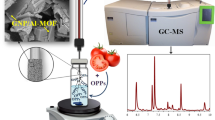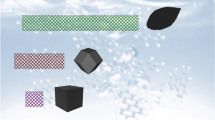Abstract
MOF-derived zink and nitrogen co-doped porous carbon (ZNPC) was synthesized through the pyrolysis of MOF-5-NH2 and used as a solid-phase microextraction (SPME) coating material. Coupled with gas chromatography-mass spectrometry (GC–MS), headspace SPME (HS-SPME) based on ZNPC was adopted for the determination of phenols in food samples. The co-existence of N and Zn in ZNPC endows the derived carbon superior hydrophilicity, which is highly beneficial for phenols capture. After optimizing the conditions of extraction and desorption, a sensitive analytical method was established with low limits of detections (LODs, 0.73–2.3 ng g−1) and wide linear ranges (5–5000 ng g−1). Both the intra-fiber repeatability (RSDs from 2.8–7.3%) and inter-fiber reproducibility (RSDs from 9.7–11.7%) were satisfactory. The established method was applied to phenol determination in beef jerky and duck neck with satisfactory recoveries of 81.2–120.4% and RSDs of 2.8–9.9%, which met well with the requirement of practical application.
Graphical abstract





Similar content being viewed by others
References
Wang Y, Ma RY, Xiao RB, Hao L, Wu QH, Wang C, Wang Z (2018) A hyper-crosslinked polymer as an adsorbent for the extraction of chlorophenols. Microchim Acta 185:1–10
Huang L, Li L, Shuai Q, Hu S (2021) Solvent-free synthesis of phenolic hydroxyl enriched ordered mesoporous polymer as an efficient solid-phase microextraction coating for the determination of trace phenols in food samples. Food Anal Methods 14:1875–1884
Dos Santos RR, Vidotti Leal LD, de Lourdes CZ, Menezes HC (2019) Determination of polycyclic aromatic hydrocarbons and their nitrated and oxygenated derivatives in coffee brews using an efficient cold fiber-solid phase microextraction and gas chromatography mass spectrometry method. J Chromatogr A 1584:64–71
Piri-Moghadam H, Alam MN, Pawliszyn J (2017) Review of geometries and coating materials in solid phase microextraction: opportunities, limitations, and future perspectives. Anal Chim Acta 984:42–65
Piri-Moghadam H, Ahmadi F, Pawliszyn J (2016) A critical review of solid phase microextraction for analysis of water samples. Trac-Trends Anal Chem 85:133–143
Zhang ZY, Pawliszyn J (1995) Quantitative extraction using an internally cooled solid phase microextraction device. Anal Chem 67:34–43
Li L, Huang L, Sun S, Yan Q, Shuai Q, Hu S (2019) An amino-functionalized ordered mesoporous polymer as a fiber coating for solid phase microextraction of phenols prior to GC-MS analysis. Microchim Acta 186:665
Mondal S, Xu J, Chen G, Huang S, Huang C, Yin L, Ouyang G (2019) Solid-phase microextraction of antibiotics from fish muscle by using MIL-101(Cr)NH2-polyacrylonitrile fiber and their identification by liquid chromatography-tandem mass spectrometry. Anal Chim Acta 1047:62–70
Shokrollahi M, Seidi S, Fotouhi L (2020) In situ electrosynthesis of a copper-based metal–organic framework as nanosorbent for headspace solid-phase microextraction of methamphetamine in urine with gc-fid analysis. Microchim Acta 187:548
Amini S, Ebrahimzadeh H, Seidi S, Jalilian N (2021) Preparation of polyacrylonitrile/Ni-MOF electrospun nanofiber as an efficient fiber coating material for headspace solid-phase microextraction of diazinon and chlorpyrifos followed by CD-IMS analysis. Food Chem 350:129242
Zheng J, Coauthors (2018) Fabrications of novel solid phase microextraction fiber coatings based on new materials for high enrichment capability. Trac-Trends Anal Chem 108:135–153
Murtada K (2020) Trends in nanomaterial-based solid-phase microextraction with a focus on environmental applications-a review. Trends Environ Anal Chem 25:e00077
Khataei MM, Yamini Y, Shamsayei M (2021) Applications of porous frameworks in solid-phase microextraction. J Sep Sci 44:1231–1263
Yang XY, Chen LH, Li Y, Rooke JC, Sanchez C, Su BL (2017) Hierarchically porous materials: synthesis strategies and structure design. Chem Soc Rev 46:481–558
Zheng J, Chen LY, Xie XT, Tong Q, Ouyang GF (2020) Polydopamine modified ordered mesoporous carbon for synergistic enhancement of enrichment efficiency and mass transfer towards phenols. Anal Chim Acta 1095:109–117
Mendiola-Alvarez SY, Palomino GT, Guzmán-Mar J, Hernández-Ramírez A, Hinojosa-Reyes L, Cabello CP (2020) Magnetic porous carbons derived from cobalt (ii)-based metal–organic frameworks for the solid-phase extraction of sulfonamides. Dalton Trans 49:8959–8966
Saraji M, Mehrafza N (2016) Mesoporous carbon–zirconium oxide nanocomposite derived from carbonized metal organic framework: a coating for solid-phase microextraction. J Chromatogr A 1460:33–39
Zhang X, Zang XH, Wang JT, Wang C, Wu QH, Wang Z (2015) Porous carbon derived from aluminum-based metal organic framework as a fiber coating for the solid-phase microextraction of polycyclic aromatic hydrocarbons from water and soil. Microchim Acta 182:2353–2359
Wei F, He Y, Qu X, Xu Z, Zheng S, Zhu D, Fu H (2019) In situ fabricated porous carbon coating derived from metal-organic frameworks for highly selective solid-phase microextraction. Anal Chim Acta 1078:70–77
Ni CY, Huang JL, Xie XT, Shi YR, Zheng J, Ouyang GF (2019) Simple fabrication of zirconium and nitrogen co-doped ordered mesoporous carbon for enhanced adsorption performance towards polar pollutants. Anal Chim Acta 1070:43–50
Wang J, Wang Y, Hu H, Yang Q, Cai J (2020) From metal-organic frameworks to porous carbon materials: recent progress and prospects from energy and environmental perspectives. Nanoscale 12:4238–4268
Sun XJ, Coauthors, (2019) Novel MOF-5 derived porous carbons as excellent adsorption materials for n-hexane. J Solid State Chem 271:354–360
Sun S, Huang L, Xiao H, Shuai Q, Hu S (2019) In situ self-transformation metal into metal-organic framework membrane for solid-phase microextraction of polycyclic aromatic hydrocarbons. Talanta 202:145–151
Li HH, Shi W, Zhao KN, Li H, Bing YM, Cheng P (2012) Enhanced hydrostability in Ni-doped MOF-5. Inorg Chem 51:9200–9207
Jaafar NF, Najman AMM, Marfur A, Jusoh NWC (2020) Strategies for the formation of oxygen vacancies in zinc oxide nanoparticles used for photocatalytic degradation of phenol under visible light irradiation. J Photochem Photobiol A 388:112202
Thommes M (2016) Physisorption of gases, with special reference to the evaluation of surface area and pore size distribution (IUPAC Technical Report). Pure Appl Chem 87(1):25–25
Hoekstra J, Beale AM, Soulimani F, Versluijs-Helder M, Geus JW, Jenneskens LW (2015) Base metal catalyzed graphitization of cellulose: a combined Raman spectroscopy, temperature-dependent X-ray diffraction and high-resolution transmission electron microscopy study. J Phys Chem C 119:10653–10661
Ding M, Shi W, Guo L, Leong ZY, Baji A, Yang HY (2017) Bimetallic metal–organic framework derived porous carbon nanostructures for high performance membrane capacitive desalination. J Mater Chem A 5:6113–6121
Zhang LJ, Wang XY, Wang RH, Hong MC (2015) Structural evolution from metal-organic framework to hybrids of nitrogen-doped porous carbon and carbon nanotubes for enhanced oxygen reduction activity. Chem Mater 27:7610–7618
Gubin A, Sukhanov P, Kushnir A, Shikhaliev K, Potapov M, Kovaleva E (2021) Monitoring of phenols in natural waters and bottom sediments: preconcentration on a magnetic sorbent, GC-MS analysis, and weather observations. Chem Pap 75:1445–1456
Wang GH, Lei YQ (2017) Fabrication of metal-organic framework MOF-177 coatings on stainless steel fibers for head-space solid-phase microextraction of phenols. Bull Environ Contam Toxicol 99:270–275
Li QL, Huang F, Wang XL, Wang X, Zhao RS (2017) Multiple-helix Cobalt(II)-based metal-organic nanotubes on stainless steel fibers for solid-phase microextraction of chlorophenol and nitrophenols from water samples. Microchim Acta 184:1817–1825
Wang WC, Wang JT, Zhang SH, Cui PL, Wang C, Wang Z (2016) A novel Schiff base network-1 nanocomposite coated fiber for solid-phase microextraction of phenols from honey samples. Talanta 161:22–30
Liu Y, Co-authors, (2018) A graphene oxide-based polymer composite coating for highly-efficient solid phase microextraction of phenols. Anal Chim Acta 1015:20–26
Meng WK, Liu L, Wang X, Zhao RS, Wang ML, Lin JM (2018) Polyphenylene core-conjugated microporous polymer coating for highly sensitive solid-phase microextraction of polar phenol compounds in water samples. Anal Chim Acta 1015:27–34
Gong SX, Wang X, Chen Y, Cheng CG, Wang ML, Zhao RS (2015) Carboxylated solid carbon spheres as a novel solid-phase microextraction coating for sensitive determination of phenols in environmental water samples. J Chromatogr A 1401:17–23
Funding
This work was supported by the National Natural Science Foundation of China (21806148) and the Natural Science Foundation of Zhejiang Province (LY21B070009).
Author information
Authors and Affiliations
Corresponding authors
Ethics declarations
Competing interests
The authors declare no competing interest.
Credit authorship statement
Qian Yan: investigation, software, and writing—original draft; Lijin Huang: conception, review and editing, and funding acquisition; Weikang Guo: data analysis and review; Lei Ouyang: review and editing; Qin Shuai: resource acquisition.
Additional information
Publisher’s note
Springer Nature remains neutral with regard to jurisdictional claims in published maps and institutional affiliations.
Supplementary Information
Below is the link to the electronic supplementary material.
Rights and permissions
About this article
Cite this article
Yan, Q., Huang, L., Guo, W. et al. Metal organic framework derived Zn/N co-doped hydrophilic porous carbon for efficient solid phase microextraction of polar phenols. Microchim Acta 188, 400 (2021). https://doi.org/10.1007/s00604-021-05060-0
Received:
Accepted:
Published:
DOI: https://doi.org/10.1007/s00604-021-05060-0




